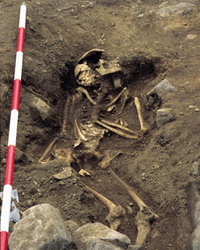Archaeologists may find remains of last Russian czar's heir
The remains of the last czar's son, missing since the royal family was gunned down by Bolsheviks, may have at last been found.

Bones found in a burned area in the ground near Yekaterinburg, the city where Czar Nicholas II and his wife and children were held prisoner and shot in 1918, belong to a boy and a young woman roughly the ages of the czar's 13-year-old son Alexei and a daughter whose remains have also never been found, Sergei Pogorelov said.
If confirmed, the finding would solve a persistent mystery and fill in a missing chapter in the story of the doomed family - victims of the violent 1917 Bolshevik Revolution that ushered in more than 70 years of Communist rule.
It comes almost a decade after remains identified as those of Nicholas his wife and other children were reburied in a ceremony made possible by the Soviet collapse but shadowed by statements of doubt - including from within the Russian Orthodox Church - about their authenticity.
The spot where the remains were found this summer appears to correspond to a site described in writing by Yakov Yurovsky, the leader of the family's killers, said Pogorelov, deputy head of the archaeological research department at a regional center for the preservation of historical and cultural monuments in Yekaterinburg.
"An anthropologist has determined that the bones belong to two young individuals - a young male he found was aged roughly 10-13 and a young woman about 18-23," he told NTV television by telephone.
Nicholas abdicated in 1917 as revolutionary fervor swept Russia, and he and his family were detained. The next year, they were sent to the Ural Mountains city of Yekaterinburg, where a firing squad executed them on July 17, 1918.
Historians say Communist guards lined up and shot Nicholas, his wife Alexandra, their five children and four attendants in a small room in the basement of a nobleman's house where they were held. The bodies were loaded in a truck and disposed of first in a mine shaft, according to most accounts.
Parts of the royal bodies were exhumed in 1991 - the year the Soviet Union fell apart, ending Communist rule - and reburied in the imperial-era capital, St. Petersburg, in 1998. But the bodies of Alexei and one of the czar's daughters, either Maria or Anastasia, have remained missing.
The Russian Orthodox Church canonized Nicholas, Alexandra, Alexei and his four sisters as martyrs in 2000. But the church cited the two missing corpses and questions over whether the recovered bones were actually those of the royal family in its decision to scale down its participation in the 1998 burial ceremony.
Historian Edvard Radzinsky, the author of a book about Nicholas II, told NTV that if the remains are confirmed to those of Alexei and a sister, it would prove the authenticity of the earlier find by providing "documentary affirmation of what is written in Yurovsky's notes."
According to NTV, a 1934 report based on Yurovsky's words indicated that the bodies of nine victims were doused with sulfuric acid and buried along a road, while those of Alexei and a sister were burned and left in a pit nearby.
Along with the remains of the two people, NTV said the archaeologists discovered shards of a ceramic container of sulfuric acid as well as nails, metal strips from a wooden box, and bullets of various caliber.
It said they found the remains in a weekslong search using metal detectors and metal rods as probes, not by digging.
Pogorelov said the remains and other items found must undergo further tests.
A representative of the Romanovs - the royal family whose rule was ended by the Revolution - urged caution.
"It is necessary to treat these findings very cautiously," Ivan Artseshchevsky told NTV from London, citing the controversy over the bones identified as those of the czar and others killed. He said tiny statistical margins of error in the identifications had sparked "huge doubts and many disputes."
Subscribe to Pravda.Ru Telegram channel, Facebook, RSS!



